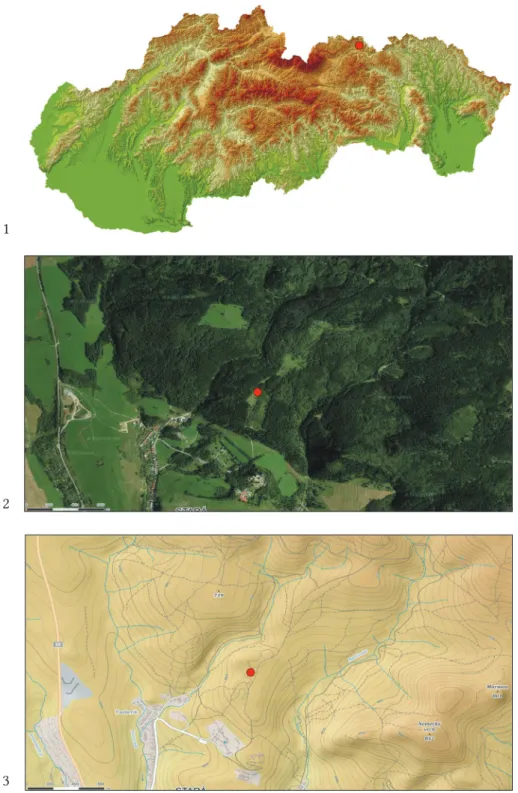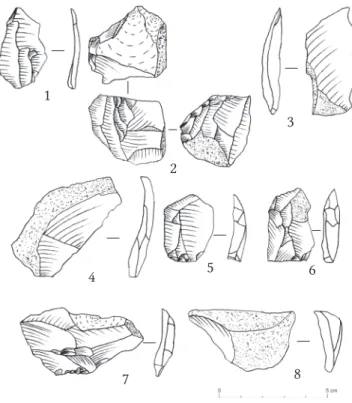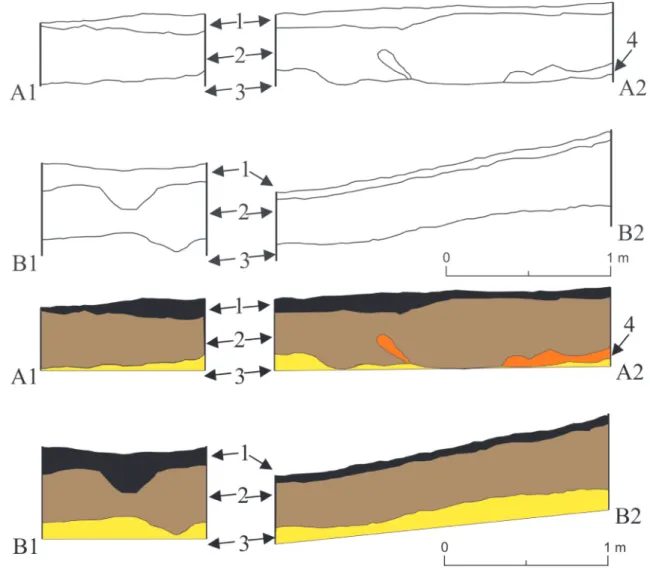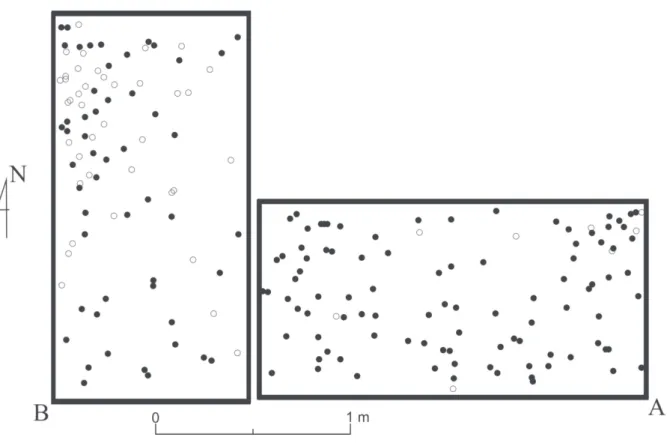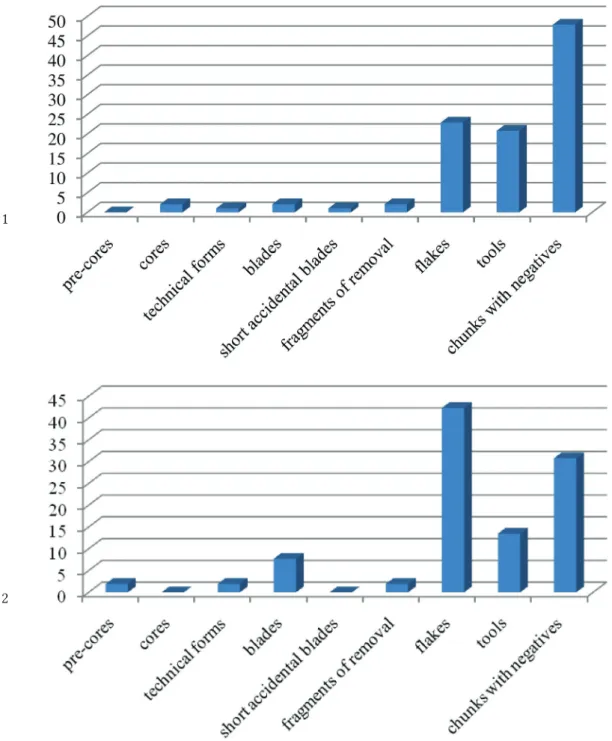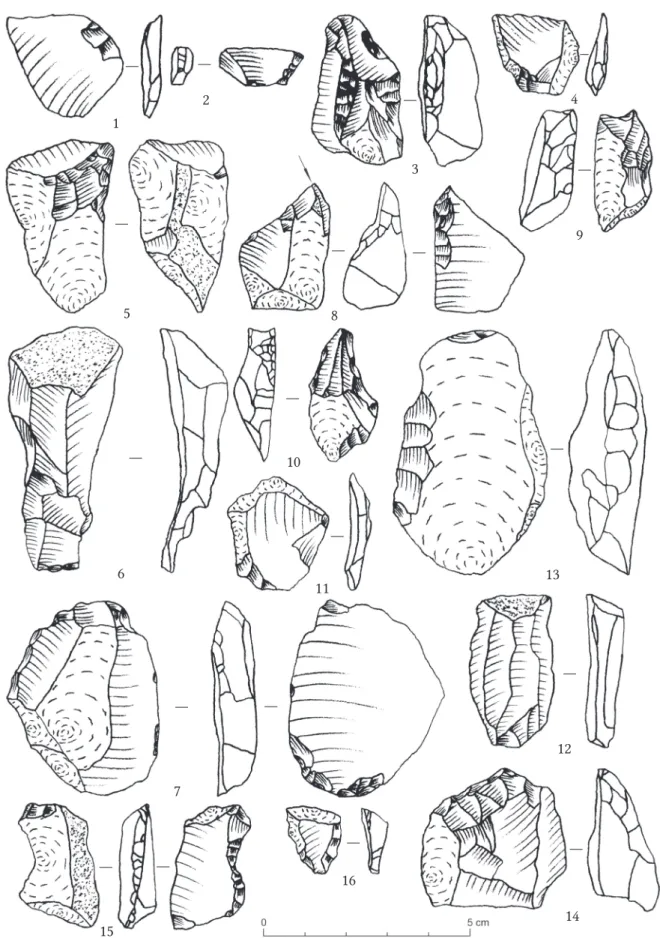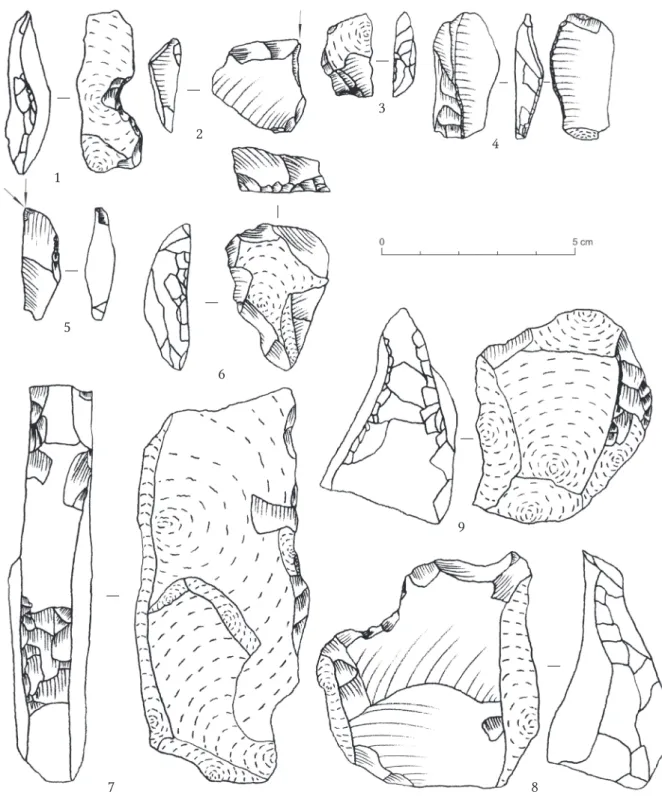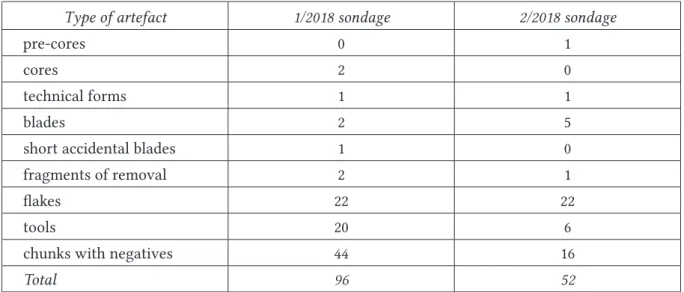Dissertationes Archaeologicae
ex Instituto Archaeologico
Universitatis de Rolando Eötvös nominatae Ser. 3. No. 8.
Budapest 2020
Dissertationes Archaeologicae ex Instituto Archaeologico Universitatis de Rolando Eötvös nominatae
Ser. 3. No. 8.
Editor-in-chief:
Dávid Bartus Editorial board:
László Bartosiewicz László Borhy Zoltán Czajlik
István Feld Gábor Kalla
Pál Raczky Miklós Szabó Tivadar Vida
Technical editor:
Gábor Váczi Proofreading:
Szilvia Bartus-Szöllősi Zsófia Kondé Márton Szilágyi
Aviable online at http://ojs.elte.hu/dissarch Contact: dissarch@btk.elte.hu
ISSN 2064-4574
© ELTE Eötvös Loránd University, Institute of Archaeological Sciences Layout and cover design: Gábor Váczi
Budapest 2020
Contents
Articles
Maciej Wawrzczak – Zuzana Kasenčáková 5
Stará Ľubovňa – Lesopark. Late Palaeolithic site and the problems associated with raw material mining
Attila Péntek – Norbert Faragó 21
Chipped stone assemblages from Schleswig-Holstein (North Germany) in the collection of the Institute of Archaeological Sciences – ELTE Eötvös Loránd University
Bence Soós 49
Middle Iron Age Cemetery from Alsónyék, Hungary
Tamás Szeniczey – Tamás Hajdu 107
Appendix – Results of the analysis of the Early Iron Age human remains unearthed at Alsónyék, Hungary
Lajos Juhász – József Géza Kiss 111
Bound in bronze – a Roman bronze statuette of a barbarian prisoner
Csilla Sáró 117
The fibula production of Brigetio: clay moulds
Field Reports
András Füzesi – Knut Rassmann – Eszter Bánffy – Hajo Hoehler-Brockmann – Gábor Kalla – Nóra Szabó – Márton Szilágyi – Pál Raczky 141 Test excavation of the “pseudo-ditch” system of the Late Neolithic settlement complex
at Öcsöd-Kováshalom on the Great Hungarian Plain
Gábor Váczi – László Rupnik – Zoltán Czajlik – Gábor Mesterházy –
Bettina Bittner – Kristóf Fülöp – Denisa M. Lönhardt – Nóra Szabó 165 The results of a non-destructive site exploration and a rescue excavation at the site
of Pusztaszabolcs-Dohányos völgy északi part
Dávid Bartus – László Borhy – Szilvia Joháczi – Emese Számadó 181 Excavations in the legionary fortress of Brigetio in 2019
Dávid Bartus – László Borhy – Emese Számadó – Lajos Juhász – Bence Simon –
Ferenc Barna – Anita Benes – Szilvia Joháczi – Rita Olasz – Melinda Szabó 189 Excavations in Brigetio in 2020
Thesis Abstracts
Anett Osztás 205
The settlement history of Alsónyék–Bátaszék.
Complex analysis of its buildings in the context of the Lengyel culture
Csilla Száraz 229
The region of the Zala and Mura Rivers (Zala County) in the Late Bronze Age.
Late Tumulus and Urnfield period
Ágnes Király 239
Human remains unearthed in settlement context from the Late Bronze Age – Early Iron Age (Reinecke BD–HaB3) Northeastern Hungary
Gergely Bóka 243
Transformation of settlement history in the Körös Region in the period between the Late Bronze Age and the end of Iron Age
Gabriella G. Delbó 263
Pottery production of the settlement complex of Brigetio
Adrienn Katalin Blay 281
Die Beziehungen zwischen dem Karpatenbecken und dem Mediterraneum von der II. Hälfte des 6. bis zum 8. Jahrhundert n. Chr. anhand Schmuckstücken und Kleidungszubehör
Levente Samu 293
Die mediterranen Kontakte des Karpatenbeckens in der Früh- und Mittel- awarenzeit im Licht der Männerkleidung. Gürtelschnallen und Gürtelgarnituren
Reviews
Gábor Mesterházy 299
Czajlik, Z. – Črešnar, M. – Doneus, M. – Fera, M. – Hellmith Kramberger, A. – Mele, M. (eds): Researching Archaelogical Landscapes Across Borders – Strategies, Methods and Decisions for the 21th Century. Graz–Budapest, 2019.
DissArch Ser. 3. No. 8. (2020) 5–20. 10.17204/dissarch.2020.5
Stará Ľubovňa – Lesopark. Late Palaeolithic site
and the problems associated with raw material mining
Maciej Wawrzczak Zuzana Kasenčáková
Institute of Archaeology and Ethnology 376 A.D. Ltd.
Polish Academy of Sciences Prešov
Institute of Archaeology kasencakova.zuzana@gmail.com
Slovakian Academy of Sciences Subdivision – OZV Spiš m.wawrzczak@interia.pl
Abstract
A new archaeological site was discovered accidentally in year 2018. A surface survey revealed stone artefacts, which were generally dated to the Late Palaeolithic. Later, archaeological sondages were opened and newly found stone artifacts proved earliest dating. Furthermore, it was confirmed that local radiolarites were exploited by Late Palaeolithic societies.
Introduction
Research in the mountainous areas are undoubtedly one of the most important directions within the archaeological field of study. They indicate that geographically diverse communi- ties were settled since the Palaeolithic. Nowadays, hardly accessible mountainous areas are very interesting places for archaeological works, mostly due to existing dense vegetation.
Before 2018, archaeological works in this area had been only concentrated in the valley of Poprad, where a Palaeolithic site was localized with material dated mainly to the Late Palae- olithic (Epigravettian and Magdalenian cultures). Moreover, Middle Palaeolithic artefacts and Neolithic materials were found there also.1 However, this site is located in a different land- scape zone, than the newly discovered place, described below.
The Stará Ľubovňa – Lesopark site was localized surprisingly during a family trip to a recre- ational area of the town, where stone materials were found on the surface. After the site was thoroughly surveyed and some material was collected, it was decided to begin archaeological excavations. The purpose of this research was to describe its chronological position. During this works more artefacts were discovered, which are kept together with the documentation in the Museum of Stará Ľubovňa.2
Site location
The newly discovered site is located in the northern part of Slovakia (Fig. 1.1), within a recre- ational zone in the area of Stará Ľubovňa. It is located in Ľubovnianska vrchovina, which is a
1 Valde-Nowak et al. 2007.
2 Kasenčáková – Wawrzczak 2018; Kučerová et al. 2020, 86.
6
Maciej Wawrzczak – Zuzana Kasenčáková
part of the Magura nappe-group of the flysch belt of the Magura unit,3 made of brown, clayey soil.4 At this moment the site is covered by meadows, overgrown with grass and nearby forest (Fig. 1.2). It’s situated on the southern slope of the hill and also spreads to the relatively flat area of the foothill. The hill extends to a small, unnamed watercourse, which is a left-bank trib- utary of the Pasterník Stream – a right-bank tributary of Poprad River (Fig. 1.3). The research area is situated at an altitude of 676 m a.s.l.
3 Nemčok 1990, 52.
4 Kunáková et al. 2016, 340.
Fig. 1. The location of Stará Ľubovňa – Lesopark site: 1 – in the area of Slovakia, 2 – site location in terms of vegetation cover, 3 – in the relation to landforms.
1
2
3
7 Stará Ľubovňa – Lesopark. Late Palaeolithic site and the problems…
Archaeological excavations
As it was mentioned above, the site was accidentally discovered. A flake made of red-green radiolarite was found at the surface in the border zone between the meadow and the forest (Fig. 2.1), while a core made of green radiolarite (Fig. 2.2), a blade (Fig. 2.3) and five flakes made of red radiolarite (Fig. 2.4–8) were found in the forest. Despite the fact, that blade and flakes are not very characteristic and primarily came from the first stages of the raw material pro- cessing, the found core seemed to be dated to the Late Palaeolithic period.5
The discovery of the artefacts led to a de- cision to conduct a small archaeological excavation and two small sondages were established. Sondage 1/2018 (size 2×1 m) was located on the border of meadow and the forest, whereas 2/2018 sondage was situated in the forest (Fig. 3). Works were carried out manually and explora- tion of levels was done every 5 cm.
Stratigraphy
The stratigraphy revealed during the ar- chaeological works can be summarized as follows (Fig. 4: A.1 – W profile, A.2 – N profile, B.1 – N profile, B.2 – W profile):
there was a 30–40 cm thick clay layer (2) of brown colour under a few centimetres thick, dark brown humus layer (1); the clay layer was situated directly on barren soil in the form of grey, impermeable lay- er of loam (3). Furthermore in the 1/2018 sondage, the presence of orange sandy layer (4) with lower (clayey) layer admix- ture (Fig. 4.A.2) was confirmed. In both cases the cultural layer was contempora- neous with layer 2, except that in 2/2018 sondage artefacts were also found in the humus layer (layer 1).
In both sondages stone artifacts were not associated in clusters, but relative- ly evenly dispersed (Fig. 5.A,B). Also, no clusters were observed in the next exploration levels. The most number of artefacts in cultural layer were between 25–40 cm in sondage 1/2018 and 10–20 cm in sondage 2/2018.
5 comp. Bańdo et al. 1992, 23. Fig. 12.2.
Fig. 2. Stará Ľubovňa – Lesopark site. Stone artifacts found during surface survey: 1, 4–8 – flakes, 2 – core, 3 – blade. Raw materials: 1 – red-green radiolarite, 2 – green radio-larite, 3–8 – red radiolarite.
Fig. 3. The location of sondages (test excavations) in Stará Ľubovňa – Lesopark site.
1
2
3
4 6
7 8
5
8
Maciej Wawrzczak – Zuzana Kasenčáková
Stone items
During archaeological works 196 various stone materials were discovered in both sondages:
105 pieces in 1/2018 sondage and 91 pieces within 2/2018 sondage. Some of the items were just natural chunks that didn’t show any marks of intentional knapping. This category included 9 objects in 1/2018 sondage and 39 pieces in 2/2018 sondage (Fig. 6). It may indicate differences in intra-site organization.
Stone materials that originated from both sondages can be assigned in 100% as made from local radiolarite. In the nearest area, there are radiolarite outcrops, in example in Jarabina or Litmanová villages,6 so this raw material have local origin. The most frequent is the red colour variant, represented by 82 items in the 1/2018 sondage and 88 items in 2/2018 sondage. The percentage of radiolarite varieties confirms that certain varieties were much more prefered than the other (Fig. 7). It is worth to mention that varieties of red radiolarite were mainly used also in the site of Stará Ľubovňa – Pod Štokom II.7
6 see Biernat et al. 2013, 2 for further reading.
7 see Valde-Nowak et al. 2007, 11. Tab. 2.
Fig. 4. Stratigraphy of 1/2018 (A) and 2/2018 (B) sondages located in Stará Ľubovňa – Lesopark site.
1 – dark brown hummus, 2 – brown loamy clay (cultural layer), 3 – grey loamy barren soil, 4 – orange sandy-loamy layer.
9 Stará Ľubovňa – Lesopark. Late Palaeolithic site and the problems…
Fig. 5. Planigraphy of stone materials in Stará Ľubovňa – Lesopark site: 1/2018 (A) sondage and 2/2018 (B) sondage. Full rectangle – artifact – empty rectangle – natural raw material.
Fig. 6. Differences in stone materials – comparison of artifacts and raw material collected in Stará Ľubovňa – Lesopark site: 1 – 1/2018 sondage, 2 – 2/2018 sondage.
1 2
Fig. 7. Diversity of stone materials showing radiolarite colour variations in Stará Ľubovňa – Lesopark site: 1 – 1/2018 sondage, 2 – 2/2018 sondage.
1 2
10
Maciej Wawrzczak – Zuzana Kasenčáková Stone artefacts
During the archaeological excavations further divergence were confirmed between the both sondages. Apart from differences in participation of natural chunks which didn’t have any marks of knapping in 1/2018 and 2/2018 (see above), it was noticed that there were also some dissimilarities between both sondages in the structure of the collection. The data is displayed on Figure 8 and Table 1.
The calculation shows, that the largest percentage in 1/2018 sondage is represented by nega- tive chunks, followed by flakes and tools (Fig. 8.1). The most numerous in 2/2018 sondage are flakes, followed by negative chunks, while tools are the third numerous (Fig. 8.2).
Fig. 8. The types of artifacts collected in Stará Ľubovňa – Lesopark site: 1 – 1/2018 sondage, 2 – 2/2018 sondage.
1
2
11 Stará Ľubovňa – Lesopark. Late Palaeolithic site and the problems…
Fig. 9. Stone artifacts from 1/2018 sondage in Stará Ľubovňa – Lesopark site: 1, 4, 11 – flakes, 2, 16 – fragments of retouched blades or flakes, 3, 9, 10 – perforators, 5 – initial core, 6 – crested blade of the second series, 7 – combined tool end-scraper + knife, 8 – medial truncation burin, 12 – accidental blade, 13 – knife (?), 14 – end-scraper, 15 – fragment of retouched flake. Raw materials: 1–11, 15, 16 – red radiolarite, 12 – steel-grey radiolarite, 13, 14 – green radiolarite.
1
2
3
4
5
6
7
8
9
10
11
12 13
15 14
16
12
Maciej Wawrzczak – Zuzana Kasenčáková
Therefore, the explanation about functional differentiation of these places seems acceptable.
Both sondages revealed large percentage of negative chunks. High rate of this kind of artefacts probably resulted from core exploitations or these products are fragments of cores.8 It is a common feature of both places.
8 comp. Libera 2019, 203.
Fig. 10. Stone artifacts from 1/2018 sondage in Stará Ľubovňa – Lesopark site: 1 – retouched natural stone, 2 – truncated burin, 3 – fragment of retouched flake, 4 – fragment of retouched crested blade of the second series, 5 – dihedral burin, 6 – amorphous end-scraper, 7, 8 – mining tools, 9 – a tool in the initial stage of development. Raw materials: 1–6, 8, 9 – red radiolarite, 7 – green radiolarite.
1
2
3
4
5
6
7 8
9
13 Stará Ľubovňa – Lesopark. Late Palaeolithic site and the problems…
As mentioned earlier, certain divergence appeared at the same time. Statistically, more tools are in 1/2018 sondage, whereas flakes predominate in 2/2018. It may prove the preliminary treatment of raw stone materials that occurred in places covered nowadays with forest, and further act of preparing products (cores, semi-products, tools) in places nowadays dominated by meadows. It is more likely, when we take a look at flakes category from 2/2018 sondage.
These are massive cortex forms (cortical flakes), with big bulbs visible (Fig. 12.2–7,9). They Fig. 11. Stone artifacts from 2/2018 sondage in Stará Ľubovňa – Lesopark site: 1 – single blow burin, 2 – fragment of blade or flake, 3 – fragment of retouched blade, 4, 11 – retouched flakes, 5, 7, 8 – flakes, 6 – fragment of blade from bipolar core, 9 – pre-core, 10 – blade. Raw materials: all made of red radiolarite.
1
2
3
4
5
6 7
8
9 10
11
14
Maciej Wawrzczak – Zuzana Kasenčáková
resemble forms associated with the initial phase of raw material processing.9 They can be compared to flake and blade blanks (Fig. 9.1,4,11,12), which seems to be knapped from prepared cores.10 Certainly, semi-products of prepared character were also found in the 2/2018 sondage (Fig. 11.6,10). Furthermore, two cores were found in 1/2018 sondage, admittedly in an initial
9 e.g. Ginter 1974, 119. Pl. XXXIV; Sobczyk 1993, Pl. XIII; Pl. XIV.
10 see e.g. Rakoca – Rozbiegalski 2015, 416.
Fig. 12. Stone artifacts from 2/2018 sondage in Stará Ľubovňa – Lesopark site: 1 – over-passed blade, 2–7, 9 – flakes, 8 – end-scraper. Raw materials: 1–5, 7–9 – red radiolarite, 6 – green radiolarite.
1
2
3 4
5
6
7 8
9
15 Stará Ľubovňa – Lesopark. Late Palaeolithic site and the problems…
form (Fig. 9.5), but the second sondage did not reveal any cores, only a pre-core (Fig. 11.9), which also can be significant. The other categories of findings are occasionally represented. It is also worth to mention the large amounts of natural fragments or blocks in the 2/2018 sond- age (see above). This kind of accumulation suggests that the place was used for pre-processing of extracted raw materials, especially near mining areas.11
Tools
Tools were distinguished in both 1/2018 and 2/2018 sondages. This kind of items were much more numerous in the area of 1/2018 sondage (Fig. 8).
The sondage 1/2018 revealed, among others, fragments of retouched blades or flakes (Fig.
9.2,15,16; Fig. 10.3,4), perforators (Fig. 9.3,9,10), a knife and end-scraper combined (Fig. 9.7), burins (Fig. 9.8; Fig. 10.2,5), knife-like artifact (Fig. 9.13), end-scrapers (Fig. 9.14; Fig. 10.6), re- touched natural fragment (Fig. 10.1), mining tools (Fig. 10.7,8) and two products of the mining tool forms, in the form of a hoe (Fig. 10.7,8). The following were found in 2/2018 sondage: burin (Fig. 11.1), fragment of retouched blade and retouched flakes (Fig. 11.3,4,11) and an end-scraper (Fig. 12.8). Retouched blades or flakes are common, non-specific forms, typical for communi- ties that used stones as a raw material for tools.12
The presence of tools made from natural fragments is also significant (Fig. 9.13; Fig 10.1). This is characteristic of places located near sources of raw material, that could be easily available and where no attention was given to its long transport.13 This may therefore certify that the site is rich in radiolarite.
However, despite a relatively small series of tools, in the form of end-scrapers, burins and per- forators, it is possible to suggest dating within a single period and one taxonomic unit, which is possible due to typological analysis.14
Tab. 1. Composition of the archaeological material of Stará Ľubovňa – Lesopark site
Type of artefact 1/2018 sondage 2/2018 sondage
pre-cores 0 1
cores 2 0
technical forms 1 1
blades 2 5
short accidental blades 1 0
fragments of removal 2 1
flakes 22 22
tools 20 6
chunks with negatives 44 16
Total 96 52
11 Ginter 1974, 13; Lech – Werra 2013.
12 e.g. Dobrzyński – Piątkowska 2012, 57; Bobak – Połtowicz-Bobak 2009, 138.
13 see e.g. Bargieł – Libera 1996, 37; Ginter 1974, 36; Trela-Kieferling 2017, 51.
14 Ginter – Kozłowski 1990.
16
Maciej Wawrzczak – Zuzana Kasenčáková
Chronological and cultural classification
It seems that the presented finds belong to a single period – Late Palaeolithic. The closest analogies for high massive end-scraper (Fig. 9.14), amorphous form of the same kind of tool (Fig. 10.6), and also short flake form (Fig. 12.8) can be found in the Magdalenian sites.15 Burins of medial truncation form (Fig. 9.8), back truncation form (Fig. 10.2) and backed dihedral burin (Fig. 10.5) also show connections with the concerned cultural unit.16 The same note also applies to perforators (Fig. 9.3,9,10).17 Also the above mentioned core, found in this site (Fig. 2.2), may belong to that culture.18 At the same time, it should be concluded that these forms do not ap- pear to be analogous to the Epigravettian inventories, although certain connections with this cultural unit cannot be excluded.19
It should be noted that a certain settlement type related to the Epigravettian culture occurred along the Poprad river, although on a small scale.20 However, the Magdalenian culture is more strongly represented in this area.21 Thus, it should be concluded that at the moment the pre- sented material most likely can be associated with Magdalenian culture.
The question of raw material exploitation
Extremely important finds are two tools made of in the form of a hoe (see above). Therefore, it can be presumed that Stará Ľubovňa – Lesopark site was used to search and extract raw material by Late Palaeolithic community.
As for the artefacts themselves, analogies can be found in the Palaeolithic sites,22 including those dated to the Late Palaeolithic.23 However, it seems that the artefacts are universal. Their form was adapted to the function of digging up and the modification was simple and tempo- rary. Such tools are also known from Neolithic sites, for example an artefact discovered in Beskid Niski Range,24 or also from mining places rich in flint clusters, where the prepared tools were used for mining purposes.25 Similar forms of mining tool can also be found at sites dating back to the Bronze Age.26
Versatility of such artifacts can also be seen in the spread of this kind of materials. Examples from European sites were highlighted previously in the article, whereas examples of similar
15 Ginter et al. 2002, 123. Ryc. 12.1,2; Jastrzębski – Libera 1987, 16. Ryc. 6.2,11; Połtowicz-Bobak et al. 2014, 243. Ryc. 5.7,10; Sobczyk 1993, Pl. XXIII.7; Wiśniewski 2015, 137. Pl. 23.12,18.
16 Ginter 1974, Pl. XXIII.1,3; Jastrzębski – Libera 1987, 18. Ryc. 8.3; Valde-Nowak et al. 2007, 17. Pl. V.5;
Wiśniewski 2015, 153. Pl. 39.9,10.
17 Jastrzębski – Libera 1987, 33. Ryc. 20.12; Połtowicz-Bobak et al. 2014, 242. Ryc. 4.8; Przeździecki et al.
2012, Fig. 8.15,17,22; Wiśniewski 2015, 139. Pl. 25.25,28.
18 Alexandrowicz 1992, 73. Pl. III.1; Bobak et al. 2010, 71. Ryc. 8.2.
19 comp. Bánesz et al. 1992; Wilczyński 2006; Valde-Nowak 2008; Kaminská – Nemergut 2014.
20 Valde-Nowak et al. 2007, 9.
21 e.g. Drobniewicz et al. 1997; Valde-Nowak et al. 2007, 9–10; Wawrzczak – Profus 2012, 123, 125; Biernat et al. 2013, 5–7; Wawrzczak – Profus 2016, 188; Valde-Nowak et al. 2018; Wawrzczak 2018, 120; Waw- rzczak 2020, 128.
22 Šatavičius 2012, 78. Fig. 13.
23 e.g. Boschian 1995, 38. Fig. 4.
24 Budziszewski – Skowronek 2001, 153. Fig. 9.B.
25 e.g. Borkowski – Migal 1988, 86; Migal – Sałaciński 1997, 106. Fig. 8.
26 see Bargieł – Libera 1996, 46. Ryc. 6.a.
17 Stará Ľubovňa – Lesopark. Late Palaeolithic site and the problems…
products could be seen also on the African territory.27 It is therefore possible to establish the universality of mining forms for communities extracting stone raw material, regarding both – territory and chronology. In this case, the 1/2018 sondage determines dating and cultural af- filiation of artefacts with Late Palaeolithic materials and probably with Magdalenian culture.
The potential site of extraction should also be indicated. The 2/2018 sondage indicates materi- als from pre-treatment of raw material (see above). At the same time, in the forest area, where the excavation is located, traces of small ground hollows can be observed. It may be remnants of exploration and mining activities of the Late Palaeolithic societies. Wołowice mining site of Magdalenian culture can be given as a clear example, where pre-processing of artefacts and mining tools were found, whereas no typical living camp materials were present.28 The above-mentioned site also revealed mining shafts up to 2 m depth, where stone materials of production were found.29 It is therefore possible that Stará Ľubovňa – Lesopark site could be regarded as a site of mining character. If so, it would be the second prehistoric mine of stone raw materials within present-day territory of Slovakia. Previously, a mining site was discov- ered in the Biele Karpaty area, where also shafts were used to search for good quality of ra- diolarite raw material.30 Furthermore, there are known radiolarite outcrops in Slovakia (Vlara basin), where probably further mines exist.31 However, in both cases mentioned above, the artefacts were not dated as precisely as in Stará Ľubovňa – Lesopark site. The artefacts found in Sromowce Wyżne (Pieniny) could confirm the possibility of extracting radiolarite from ex- posed areas, however, this site is dated to the beginning of the Bronze Age.32
Of course, it is possible that some of the observed extractions may be dated to later epochs.
It seems probable, as raw material used for the manufacture of gunflints, was extracted from these sites in the Modern period.33 Limnosilicites material were used for production of tiles, necessary for stoves.34 This raise the possibility of some “destruction” of the Late Palaeolithic site by later modern activities.
Conclusion
In 2018, a new archaeological site Stará Ľubovňa – Lesopark was discovered. It is located in the area north to the town. Small archaeological excavations were carried out in the form of two sondages (1/2018 and 2/2018) in the same year. As a result of this work, artefacts made of local radiolarite were discovered.
Chronologically, the site should be assigned to the Late Palaeolithic. Although it is difficult to affiliate it to an appropriate unit, Magdalenian culture is suggested.
It seems, based on the findings, that this place can be considered as a mine and an occupation located in its close vicinity. This is confirm by different nature of two areas (1/2018 and 2/2018 sondages). The mine was used to extract raw material from exposed surface using the discov-
27 e.g. Christiana Köhler et al. 2017, Fig. 10.
28 see Dagnan-Ginter 1973; Kozłowski – Kozłowski 1977, 165.
29 Dagnan-Ginter 1974; Kozłowski – Kozłowski 1977, 165.
30 see Cheben – Cheben 2014 for further literature; Cheben et al. 2018.
31 Cheben et al. 1995.
32 Wawrzczak 2018, 126.
33 e.g. Simán 1995, 382.
34 Cheben – Illášová 2002, 111.
18
Maciej Wawrzczak – Zuzana Kasenčáková
ered tools (Fig. 10.7,8). Afterwards, it was pre-treated in the nearby area (2/2018 sondage), and used for making blanks and tools (1/2018 sondage).
The archaeological site Stará Ľubovňa – Lesopark appears to be incredibly interesting and opens new perspective to learn about the activities of the Late Palaeolithic societies in the Carpathian area.
References
Alexandrowicz, S. W. – Drobniewicz, B. – Ginter, B. – Kozłowski, J. K. – Madeyska, T. – Nada- chowski, A. – Pawlikowski, M. – Sobczyk, K. – Szyndlar, Z. – Wolsan, M. 1992: Excava- tions in the Zawalona Cave at Mników (Cracow Upland, Southern Poland). Folia Quaternaria 63, 43–77.
Bańdo, Cz. – Dagnan-Ginter, A. – Holen, S. – Kozłowski, J. K. – Montet-White, A. – Pawlikow- ski, M. – Sobczyk, K. 1992: Wołowice, province of Kraków (flint extraction and processing site).
Recherches Archéologiques de 1990, 5–25.
Bargieł, B. – Libera, J. 1996: Wyniki badań pracowni nakopalnianej w Nowym Rachowie. Archeologia Polski Środkowowschodniej 1, 35–48.
Bánesz, L. – Hromada, J. – Desbrosse, R. – Margerand, I. – Kozłowski, J. K. – Sobczyk, K. – Pawli- kowski, M. 1992: Le site de plein air du paléolithique supérieur de Kašov 1 en Slovaquie orien- tale (Etude préliminaire ďune structure spatiale des outillages épigravettiens en obsidienne).
Slovenská Archeológia 40, 5–28.
Biernat, M. – Soják, M. – Valde-Nowak, P. 2013: The complex of archaeological sites on the Litmano- vská hill in Jarabina (Northern Slovakia). Slovenská Archeológia 61, 1–20.
Bobak, D. – Łanczont, M. – Nowak, A. – Połtowicz-Bobak, M. – Tokarczyk, S. 2010: Wierzawice, st. 31 – nowy ślad osadnictwa magdaleńskiego w Polsce południowo-wscodniej. Materiały i Sprawozdania Rzeszowskiego Ośrodka Archeologicznego 31, 63–78.
Bobak, D. – Połtowicz-Bobak, M. 2009: Przyczynek do rozpoznania osadnictwa paleolitycznego na terenach Płaskowyżu Głubczyckiego. Dwa nowe stanowiska powierzchniowe z Pilszcza. Śląskie Sprawozdania Archeologiczne 51, 131–140.
Borkowski, W. – Migal, W. 1988: Badania wyrobisk szybu 7/610 w Krzemionkach w latach 1984–1986.
Sprawozdania Archeologiczne 40, 63–94.
Boschian, G. 1995: The “San Bartolomeo” shelter: a flint exploitation site in Central Italy. Archaeologia Polona 33, 31–40.
Budziszewski, J. – Skowronek, M. 2001: Results of the preliminary archaeological researches in the mount Cergowa massif, the Lower Beskid Mountains. Prace Komisji Prehistorii Karpat 2, 145–164.
Cheben, I. – Cheben, M. 2014: The exploration of a mining site for radiolarite in the White Carpathi- ans area. In: Bostyn, F.–Giligny, F. (eds): Lithic raw material resources and procurement in pre- and protohistoric times. Proceedings of the 4th International Conference of the UISPP Commission on Flint Mining in Pre- and Protohistoric Times (Paris, 10-11 September 2012). Oxford, 87–92.
Cheben, I. – Cheben, M. – Nemergut, A. – Soják, M. 2018: The latest knowledge on use of primary sources of radiolarites in the central Váh region (the microregion of Nemšová-Červený Kameň).
In: Werra, D. H.–Woźny, M. (eds): Between history and archaeology. Papers in honour of Jacek Lech. Oxford, 115–132. doi: 10.2307/j.ctvndv6qh.15
Cheben, I. – Illášová, Ľ. 2002: Chipped industry made of limnoquarzite from Žiarska Kotlina hollow.
In: Cheben, I.–Kuzma, I. (eds): Otázki neolitu a eneolitu našich krajín – 2001. Zborník referátov z 20. pracovného stretnutia bádateľov pre výskum neolitu a eneolitu Čiech, Moravy a Slovenska Liptovská Sielnica 9.–12. 10. 2001. Nitra, 105–112.
19 Stará Ľubovňa – Lesopark. Late Palaeolithic site and the problems…
Cheben, I. – Illášová, Ľ. – Hromada, J. – Ožvoldová, L. – Pavelčík, J. 1995: Eine Oberflächengrube zur Förderung von Radiolarit in Bolešov. Slovenská Archeológia 43, 185–204.
Christiana Köhler, E. – Hart, E. – Klaunzer M. 2017: Wadi el-Sheikh: A new archaeological investi- gation of ancient Egyptian chert mines. PLoS ONE 12, e0170840. doi: 10.1371/journal.pone.0170840 Dagnan-Ginter, A. 1973: Le problème des atelier de la taille de silex en Paléolithique superieur de
coté nord des Karpates. Acta Archaeologica Carpathica 14, 75–80.
Dagnan-Ginter, A. 1974: Wołowice (an Upper Palaeolithic workshop site). Recherches Archéologiques, 7–16.
Dobrzyński, M. – Piątkowska, K. 2012: Zagadnienie eksploatacji łuszczniowej w kulturze pucharów lejkowatych na podstawie stanowiska 8/19 w Piaskach Wielkich, pow. Świdnik, woj. lubelskie.
Materiały i Sprawozdania Rzeszowskiego Ośrodka Archeologicznego 33, 43–61.
Drobniewicz, B. – Doktor, M. – Sobczyk, K. 1997: Petrographical composition and provenance of siliceous artefacts on the archaeological sites in the region of Spisz and Pieniny Mountains (southern Poland). In: Schild, R.–Sulgostowska, Z. (eds): Man and flint – Proceedings of the VIIth International Flint Symposium Warszawa – Ostrowiec Świętokrzyski, September 1995.
Warszawa, 195–200.
Ginter, B. 1974: Wydobywanie, przetwórstwo i dystrybucja surowców i wyrobów krzemiennych w schyłkowym paleolicie północnej części Europy Środkowej. Przegląd Archeologiczny 22, 5–122.
Ginter, B. – Kozłowski, J. K. 1990: Technika obróbki i typologia wyrobów kamiennych paleolitu, mezolitu i neolitu. Warszawa.
Ginter, B. – Połtowicz, M. – Pawlikowski, M. – Skiba, S. – Trąbska, J. – Wacnik, A. – Winiarska- Kabacińska, M. – Wojtal, P. 2002: Dzierżysław 35 – stanowisko magdaleńskie na przedpolu Bramy Morawskiej. In: Gancarski, J. (ed.): Starsza i środkowa epoka kamienia w Karpatach polskich. Krosno, 111–145.
Jastrzębski, S. – Libera, J. 1987: Stanowisko późnomagdaleńskie w Klementowicach-Kolonii w świe- tle badań 1981–1982 r. Sprawozdania Archeologiczne 39, 9–52.
Kaminská, Ľ. – Nemergut, A. 2014: The Epigravettian chipped stone industry from the Nitra III site (Slovakia). In: Biró, K. T.–Markó, A.–P. Bajnok, K. (eds): Aeolian scripts. New ideas on the lithic World. Studies in honour of Viola T. Dobosi. Budapest, 93–119.
Kasenčáková, Z. – Wawrzczak, M. 2018: Stará Ľubovňa – Lesopark, okr. Stará Ľubovňa. Nálezová správa z archeologického výskumu „na ploche náhodne objaveného náleziska, parc. č. KN-C 4476 a KN-C 4357/6 k. u. Stará Ľubovňa. Manuscript in the Museum in Stará Ľubovňa. Stará Ľubovňa.
Kučerová, M. – Kasenčáková, Z. – Wawrzczak, M. 2020: Svedectvá najstaršej minulosti. In: Laincz, E. – Marcinová F. (eds): Libenow, Liblaw, Lubowla, Alt Lublau, Ólubló… Stará Ľubovňa (monografia mesta). Stará Ľubovňa, 82–115.
Kozłowski, J. K. – Kozłowski, S. K. 1977: Epoka kamienia na ziemiach polskich. Warszawa.
Kunáková, L. – Štefko, R. – Bačík, R. 2016: Evolution of the landscape potential for recreation and tourism on the example of microregion Minčol (Slovakia). E-review of Tourism Research 2, 335–354.
Lech, J. – Werra, D. 2013: Artefakty w przestrzeni prehistorycznych pól górniczych. In: Czyżewski, Ł. A. (ed.): Artefakt w przestrzeni. Krzemienica – skupienie – stanowisko – region. 10. Warsztaty Krzemieniarskie SKAM, 23 – 25 października 2013, Toruń. Toruń, 23–28.
Libera, J. 2019: Materiały ze skał krzemionkowych odkryte na stanowisku 1 w Dubecznie (Pojezierze Łęczyńsko-Włodawskie). In: Taras, H. (ed.): Dubeczno, stanowisko 1 (Pojezierze Łęczyńsko-Wło- dawskie). Materiały z badań archeologicznych w latach 1986–1987. Lublin, 197–245.
Migal, W. – Sałaciński, S. 1997: Studies at Krzemionki during the last decade. In: Schild, R.–Sulgo- stowska, Z (eds): Man and flint – Proceedings of the VIIth International Flint Symposium War- szawa – Ostrowiec Świętokrzyski, September 1995. Warszawa, 103–108.
20
Maciej Wawrzczak – Zuzana Kasenčáková
Nemčok, J. 1990: Vonkajšie flyšové pásmo. In: Nemčok, J. (ed.): Vysvetlivky ku geologickej mape Pienín, Čergova, Ľubovnianskej a Ondavskej Vrchoviny 1 : 50000. Bratislava, 51–73.
Połtowicz-Bobak, M. – Bobak D. – Gębica P. 2014: Nowy ślad osadnictwa magdaleńskiego w Polsce południowo-wschodniej. Stanowisko Łąka 11–16 w powiecie rzeszowskim. Materiały i Sprawoz- dania Rzeszowskiego Ośrodka Archeologicznego 35, 237–248. doi: 10.15584/misroa.2015.36.2 Przeździecki, M. – Migal, W. – Krajcarz, M. – Pyżewicz, K. 2012: Obozowisko kultury magdaleń-
skiej na stanowisku 95 „Mały Gawroniec” w Ćmielowie, pow. ostrowiecki, woj. świętokrzyskie (Pl. 104–115). Światowit 7(48)B, 225–234.
Rakoca, A. – Rozbiegalski, P. 2015: Charakterystyka nakopalnianej pracowni krzemieniarskiej z okresu schyłkowego paleolitu na podstawie materiałów krzemiennych ze stanowiska Kłodawa 3, pow.
Gorzowski, woj. Lubuskie. Folia Praehistorica Posnaniensia 20, 397–427. doi: 10.14746/2015.20.22 Simán, K. 1995: H1 Miskolc-Avas Hill. Prehistoric mine on the Avas hill at Miskolc. Archaeologia Polona
33, 371–382.
Sobczyk, K. 1993: The Late Palaeolithic flint workshops at Brzoskwinia-Krzemionki near Kraków. Kraków.
Šatavičius, E. 2012: Titnago kasimo ir apdirbimo dirbtuvės prie Titno ežero. Archaeologia Lituana 13, 66–83. doi: 10.15388/ArchLit.2012.0.1190
Trela-Kieferling, E. 2017: Narzędzia „podomowe” z pracowni / kopalni krzemieniarskiej w Bęble stan. 4, gm. Wielka Wieś. Acta Archaeologica Lodziensia 63, 49–57.
Valde-Nowak, P. 2008: Paleolityczne zabytki ze stanowiska Marhaň, okr. Bardejov (Słowacja). In:
Machnik, J. (ed.): Archeologia i środowisko naturalne Beskidu Niskiego w Karpatach. Część II.
Kurimská Brázda. Kraków, 139–156.
Valde-Nowak, P. – Kraszewska, A. – Cieśla, M. – Nadachowski, A. 2018: Late Magdalenian camp- site in a rock shelter at the Obłazowa Rock. In: Valde-Nowak, P.–Sobczyk, K.–Nowak, M.–
Źrałka, J. (eds): Multas per Gentes et Multa per Saecula. Amici Magistro et Collegae suo Ioanni Christopho Kozłowski Dedicant. Kraków, 175–183.
Valde-Nowak, P. – Soják, M. – Wąs, M. 2007: On the problems of the Late Palaeolithic settlement in northern Slovakia. Example of Stará Ľubovňa site. Slovenská Archeológia 55, 1–22.
Wawrzczak, M. 2018: Archeologiczne badania powierzchniowe w Pieninach. III. komunikat z prac w 2013 roku. Pieniny – Przyroda i Człowiek 15, 117–129.
Wawrzczak, M. 2020: Archeologiczne badania powierzchniowe w Pieninach. IV komunikat z prac wykonanych w 2014 roku. In: Bodziarczyk, J. (ed.): Pieniny – Przyroda i Człowiek. Monografie, 16. Kraków, 123–135.
Wawrzczak, M. – Profus, T. 2012: Archeologiczne badania powierzchniowe w Pieninach. I. Historia badań i założenia metodyczne. Pieniny – Przyroda i Człowiek 12, 117–127.
Wawrzczak, M. – Profus, T. 2016: Archeologiczne badania powierzchniowe w Pieninach. II. komu- nikat z prac w 2012 roku. Pieniny – Przyroda i Człowiek 14, 185–192.
Wilczyński, J. 2006: The Upper Paleolithic workshop at the site Piekary IIA sector XXII leyer 5.
Sprawozdania Archeologiczne 58, 175–203.
Wiśniewski, T. 2015: Magdalenian settlement in Klementowice. In: Wiśniewski, T. (ed.): Klementowice.
A Magdalenian site in eastern Poland. Lublin, 15–179.
